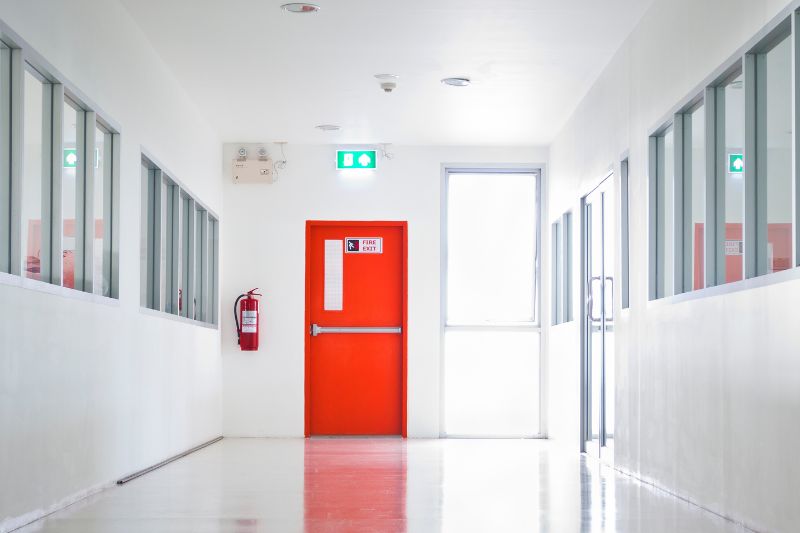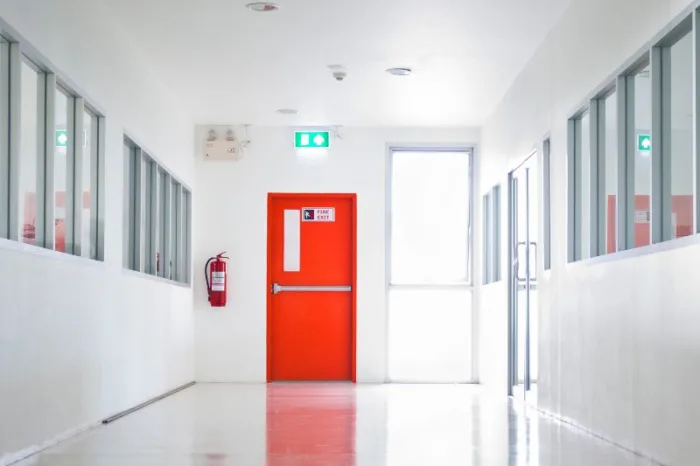Key takeaways
- An emergency building entrance system is a type of access control designed to organize the entry and exit of a building in an emergency.
- If your building has fail-safes for power outages, you can add access control to emergency exit doors to further secure it.
- Many buildings, including schools and multifamily buildings, can benefit from an emergency entrance system.

When it comes to building access control, emergency routes are important, whether they’re emergency entrances or exits. In fact, having an emergency plan in place can greatly determine the success of an emergency response in many commercial or residential buildings.
For that reason, we’ve put together this guide on emergency building entrance systems and how integral they are to forming an emergency exit plan. Then, we discuss who can benefit from emergency entrance systems and which one is the best for your property.
In this post:
- What is an emergency building entrance system?
- What is the best emergency building entrance system?
- 3 ways to use ButterflyMX as an emergency entrance system
- Can you put access control on emergency exit doors?
- Emergency building entrance system FAQs
What is an emergency building entrance system?
An emergency building entrance system is a type of access control designed to organize the entry and exit of a building in an emergency. These systems not only secure an emergency door from unauthorized use but also help monitor exit and entry events via audit trails and remote management software.
Emergency building entrance systems come in many different options, including:
- Access control hardware. Access control hardware such as video intercoms, keypads, and cloud-based software are great emergency systems for buildings because they make monitoring entry and exit door activities easy.
- Delayed egress. You’ve likely seen the delayed egress doors in retail stores where you have to hold the bar on the door down for several seconds before the door will open. These types of doors prevent theft while also allowing an emergency escape.
- Motion sensors. Motion sensors on emergency doors automatically open when they sense movement on the inside of the door. With this type of emergency system, emergency exits are quick and simple.
Who needs an emergency entrance system?
Because of the sensitive nature of emergency response plans, most commercial real estate and multifamily residential buildings must have marked emergency routes. However, some building types benefit more from emergency entrance systems than others.
Building types that need emergency entrance systems include:
- Schools
- Colleges
- Senior living facilities
- Hospitals
- Industrial plants
- Retail buildings
- Malls/shopping centers
- Fitness facilities
- Apartment buildings
- Hotels and conference centers
What is the best emergency building entrance system?
While many emergency building entrance systems are on the market, none are as robust and cohesive as ButterflyMX. ButterflyMX’s suite of products simplifies access throughout your property, from the gate to the emergency exit door.
Moreover, ButterflyMX access control products are specifically designed to work seamlessly with each other and integrated systems such as smart locks and property management systems.
The best ButterflyMX products for an emergency building entrance system include:
- Video intercom. The ButterflyMX video intercom system has a 156° wide-angle camera for remote communication with people via two-way video call. The camera also takes time—and date-stamped photos that are accessible in the cloud-based software for up to a year.
- Vehicle access control. With the vehicle access control system and windshield tags, tenants and staff won’t need to roll down their windows or wait for permission to enter or exit the parking area.
- Keypad and reader. The keypad and reader are perfect for creating a secure entrance where only authorized users can enter. With the right door strike installment, keypads and readers can be used on the same door as the emergency exit to create a seamless entry and exit point.
3 ways to use ButterflyMX as an emergency entrance system
Here are three ways ButterflyMX can help you create a reliable emergency response system for your property:
- Monitor emergency movement from anywhere
- Secure emergency exits with access control
- Communicate with tenants from anywhere
1. Monitor emergency movement from anywhere
With ButterflyMX’s access control system, monitoring people’s movement around your property is easy and efficient.
Knowing who has come and gone from the premises during an emergency can be important information. For instance, you might need to know who could have been in the building, for how long, and whether they’re still present. Not to mention, emergency officials might need a head count of people under certain circumstances.
Alternatively, our video intercom, with its wide-angle camera, takes photos of anyone who enters the property, so you have records for later in case they’re needed.
2. Secure emergency exits with access control
Emergency exits are critical points during emergencies. However, they can go unnoticed because they’re often in less-trafficked building areas.
Subsequently, because most people don’t notice these doors, some might see them as the perfect place to enter without authorization. However, using an end-to-end access control system such as ButterflyMX, you can easily monitor exit doors while making sure fail-safe measures are installed.
Discover the benefits of building-wide access:
3. Communicate with tenants from anywhere
ButterflyMX has many products that can help tenants and visitors move around the building. One of them is the front desk station software, which is easy to install on any computer, whether on-site or remote.
Using the front desk station software, property managers can monitor entry and exit events like the above products. What’s more, the software also allows visitors and tenants to communicate with property managers and staff in an emergency—even when no one is at the lobby desk.
What’s more, using the front desk station, property managers can view a live activity feed on the property without having to be on the premises. This can help managers stay updated about what’s happening in the building and keep tabs from anywhere.
Can you put access control on emergency exit doors?
Yes, you can put access control on emergency exit doors to secure your building further.
Furthermore, because the emergency exit door must be unlocked from the inside, there are certain factors that you should consider before installing access control on your emergency door.
For instance, regarding door hardware, you must use a fail-open door strike to ensure the door will still open when the power goes out. Moreover, you should also have a fail-safe option to cut power to the access control unit that’s powering security to the doors so they’re not stuck during an emergency.
Emergency building entrance system FAQs
Here are the answers to your common questions about emergency building entrance systems:
- What are the OSHA regulations for emergency exit doors?
- What is the purpose of an emergency building entrance system?
What are the OSHA regulations for emergency exit doors?
According to OSHA’s building emergency procedure and emergency exit door regulations:
- “Exits are permitted to have only those openings necessary to allow access to the exit from occupied workplace areas or to the exit discharge. Moreover, “openings must be protected by a self-closing, approved fire door that remains closed or automatically closes in an emergency.”
What is the purpose of an emergency building entrance system?
The purpose of an emergency building entrance system is to empower tenants and staff members to evacuate a building immediately and securely while simultaneously securing the property from unauthorized access.







